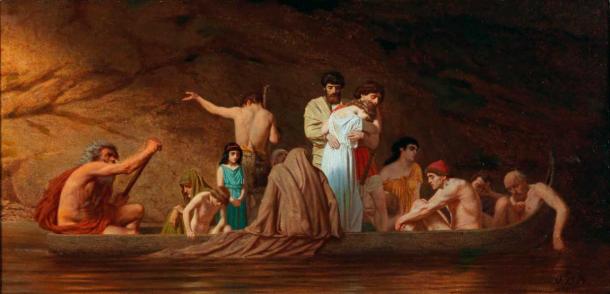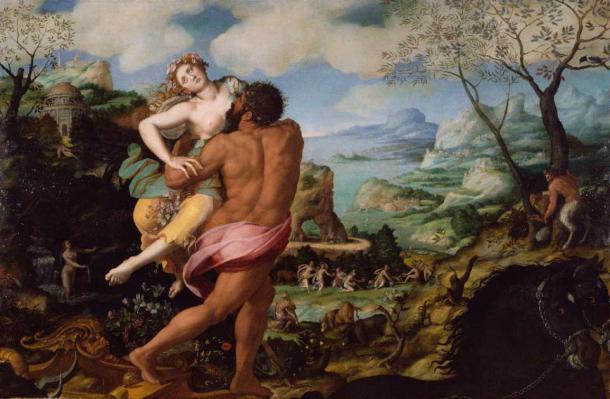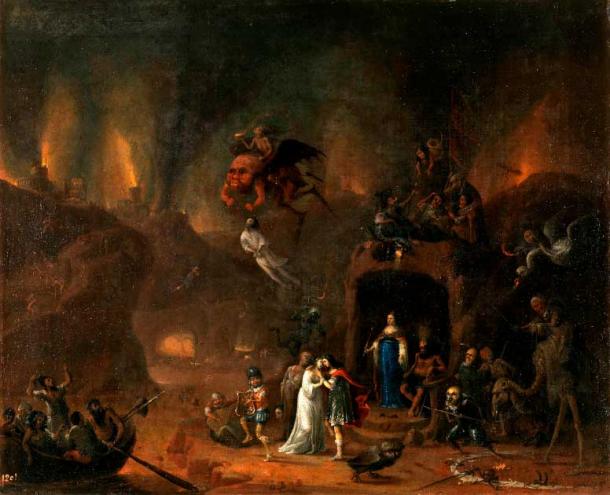Dark Sketches & Stories from the Underworld in Greek Mythology
One of the most fascinating concepts of Greek mythology is that of the underworld. The Greek underworld is one of three realms that make up the cosmos. It was believed that after death, an individual’s soul leaves his body and goes to the underworld, thus leaving his body behind.
Beyond the dead, the underworld was also the home of Hades, known as the god of the underworld. But what involvement did he have with the dead, and what was the underworld like for them? Did any other Greek myths heavily rely on such a dark and mysterious place?
A Glimpse into the Underworld
There are several descriptions of the underworld throughout Greek mythology. In these texts, the underworld is described as dark and without any sunlight. It is also located somewhere around the periphery of the Earth, either at the ends of the ocean or somewhere inside the Earth. Although there are many physical descriptions of this place, it is generally understood that the underworld is an invisible realm that cannot be easily seen or accessed.
In addition to darkness, water also plays an important role in the underworld. The underworld is filled with many rivers, including the Acheron, Styx, Pyriphlegethon, Cocytus, Lethe, and Oceanus. The most common of these is the river Styx, which is the river on which gods swear oaths. It is the only river in the underworld mentioned in Homer’s Iliad, and it is later described as the river on which the dead entered the underworld. Some texts refer to it as the “river of hatred.”
The other rivers have their own special themes as well. The Acheron is known as “the river of misery”, and is sometimes used in replacement of the Styx as the river the dead are brought over. Many necromantic rituals take place on the Acheron, and in some cases, it is described as a lake instead of a river. Flowing into the Acheron is the Pyriphlegethon, the river of blazing fire. Plato claims that the Pyriphlegethon leads the damned to Tartarus, an abyss of torture.
The Cocytus River has a similar role to the Pyriphlegethon. Known as “the river of wailing”, the Cocytus is described by Plato as a branch of the Styx that flows into the Acheron and is specifically associated with leading murderers to Tartarus. The Lethe is known as “the river of forgetfulness”, and the Oceanus is known as “the river that encircles the world.” While Lethe is not mentioned much, Oceanus is known as the boundary between the land of the living and the land of the dead.
In addition to the dismal physical layout of the Greek underworld, the underworld was also free of earthly time. Within the underworld, time itself was conceived as essentially frozen, where nothing ever changes or develops. While the dead and the gods that reside there have a general concept of past and future, they do not keep track of time the same way the living do with clocks and calendars. Because of this, it is understood that living humans wanting to visit the underworld would have to be capable of freezing time to do so.
- Ancient Gods – When Darkness Ruled the World
- Overlords of the Underworlds: 10 Gods of Death From Around the World

The dark journey to the underworld in Greek mythology was frequently guided by Charon, the ferryman (Public Domain)
The Journey of the Dead in the Greek Underworld
There are many different descriptions of the dead entering the underworld in Greek mythology, but the most common is with the assistance of Charon. Charon is the ferryman of Hades, who will row the dead over the river Styx into the underworld. This story in particular is so well-known that it can be found on some ancient artifacts pertaining to death, such as funerary vases. Some stories claim that while the dead are always separated from their bodies, their souls may not be carried by Charon to the underworld until they’ve had a proper burial.

Souls on the Banks of the Acheron, 1898 painting by Adolf Hirémy-Hirschl. Source: Public Domain
Once in the underworld, the souls of the dead are described as “insubstantial.” They are fully incapable of interacting with the living world and are careless of their surroundings. There are also no social positions present in the underworld, so all souls are finally equal. However, they were not physically or mentally changed from their identities on Earth. The dead are unable to age or mentally develop. A child, for example, would remain a naive child in the Greek underworld and never grow in size or intelligence.
The souls in the underworld in Greek mythology ultimately serve no purpose. Although they exist for eternity, they often do not do much except pass the time by playing games with one another and interacting with any items left on their graves. In some texts, the dead are able to use any items left on their grave, as they carry over to the underworld. These gifts often include games, clothing, and food. Some texts even claim that the dead are able to marry and be intimate, although of course they cannot produce children.
Interestingly, the dead were able to do all of these things in the Greek underworld, but were unable to remain conscious and alert on their own. According to Homer’s Odyssey, blood sacrifices are needed to animate the dead, as they cannot remain their true selves without the “essence of life.” Animals, rather than humans, were frequently used for these sacrifices.
Those that were perceived as wicked during their time on earth were led to Tartarus to be tortured as a form of divine punishment. A majority of these crimes are related to murder and greed, although Zeus did once throw the Titans into Tartarus after defeating them. These Titans included Zeus’s and Hades’s own father, Cronus. According to Homer, Cronus made the best of his punishment and later became the king of Tartarus.
The majority of this torture would be done by the Erinyes, three goddesses tasked with punishing the wicked for their crimes on earth. Their names are Alecto, Megaera, and Tisiphone. Their tortures included inflicting madness, starvation, disease, and physical injury. They did much of this in Tartarus; however, they were also capable of inflicting some of this punishment early in the living world depending on the circumstances.
- Thanatos: The Beautiful Reaper of Death in Greek Mythology
- Exposing the Shady Secrets of Charon's Obols: Spirit Coins of Ancient Greece

Charon the ferryman of the Greek underworld (Public Domain)
Hades’ Home Sweet Home
As previously mentioned, the underworld was home to Hades, the god of the underworld. Hades was also called Pluto, and each of his names translated into titles such as “the Unseen,” “the Wealthy One,” and “the Giver of Wealth.” Hades’ parents were Cronus (Kronos), the youngest of the Titans, and Rhea, Titan and goddess of fertility. This also made him the brother of Poseidon, Demeter, Hera, Hestia, and Zeus.
Besides Hades, the underworld is home to several other regulars, one of whom is Hades’ wife, Persephone. Persephone is known as the queen of the underworld and is the daughter of Zeus and Demeter, goddess of the harvest.
Though Persephone was Hades’ niece, he seduced her and abducted her to the underworld where they wed. Zeus had given permission for this marriage, but Demeter had not, which resulted in her refusing to grow harvests for the earth. Zeus attempted to rectify this by bringing Persephone back to her; however, Persephone had already eaten sacred pomegranate seeds from the underworld, tying her there permanently.
Other inhabitants in the underworld include Hecate, goddess of magic; the Erinyes, goddesses of vengeance; Minos, Rhadamanthus, and Aeacus, judges of the dead; Charon, the ferryman of the dead; Cerberus, the three-headed hellhound; Thanatos, the personification of death; Hypnos, the personification of sleep; Melinoë, a nymph; Achlys, the personification of misery; Styx, the goddess of the river Styx; and Eurynomos, a demon that consumes the flesh off the bodies of the dead.
Not on this list is Hermes, who was associated with the underworld but does not reside there permanently. Hermes is known as the herald of the gods and would lead the souls of the dead to the entrance of the river Styx. He would pass the souls of the dead to Charon, who would then row them over the river to their fates. At times, he would even be called to help the soul separate from the body as someone passed, such as in cases of painful or unforeseen deaths.

The abduction of Persephone, painting Alessandro Allori, 1570 (Public Domain)
Don’t Look Back: The Tale of Orpheus
Another tragic story that took place in the Greek underworld is the story of Orpheus. Orpheus was a musician, poet, and prophet in ancient Greek religion. In this story, Orpheus became one of the only mortals to ever enter the underworld from the living world.
Orpheus was such a talented musician that he was able to use his lyre-playing skills to persuade others. These skills were described as supernaturally good, because they were even capable of working on gods including Hades and Persephone. He decided to use these skills to put a spell on the guards of the underworld so he could pass through and find his wife, who tragically died of a snake bite on their wedding day.
After using his lyre to bewitch the guards, he entered and met Hades and Persephone. He used his beautiful singing voice to convince them to let him take his wife back to the land of the living. They agreed, but only under the condition that while Orpheus’s wife Eurydice followed Orpheus out of the underworld and he did not turn around to look at her. Upon reaching the entrance to the underworld, Orpheus broke the condition and turned around to look at his wife. Eurydice then faded back into the underworld, never to return to the land of the living.
Orpheus was not allowed to return to the underworld a second time to attempt to retrieve her. Devastated, he returned to the land of the living to spend the rest of his days playing his music to wildlife in the mountains.

Orpheus and Eurydice in the Greek Underworld, 1652 oil painting (Lluís Ribes Mateu / CC BY NC 2.0)
Greek Perception of the Underworld
Although the Greeks believed in the underworld of Greek mythology, they did not have a particularly positive outlook on it. Because you would remain eternally in the underworld, the Greeks did not believe that death was truly an end to life. However, they did see death as a significant blow to the meaning of life, because in death a person would no longer have any true identity. Their actions in the underworld would have no impact on themselves or the living world; therefore, they were considered meaningless.
An example of this meaninglessness was the rewarding of living heroes but not dead. The Greek gods would honor the greatest of heroes in life to honor them for their actions, but found no purpose in doing so after death given the quality of the afterlife. The gods did, however, still expect the Greeks to respect the dead by honoring their graves. Those who chose to disrespect the dead would reap severe punishments from the gods, including being sent to Tartarus if the crime was serious enough.
To the Greeks, the idea of the soul existing in the underworld after death was simply a representation of their prior life on earth, rather than their actual self living on. Because of this, some individuals, such as Homer, believed that it was better to never be born at all so you would never have to experience an eternity of meaningless existence. If you were born, it would be better to die as an infant so you would have no life experiences to lose in the underworld.
Bleak as it may seem, the concept of the Greek underworld served an important purpose to the Greek people. Described as “the afterlife for the living”, understanding the underworld gave the Greeks something vivid to expect for their loved ones and themselves someday. As the home of supernatural beings and the resting place of the deceased, the underworld itself still remains a fascinating aspect of Greek mythology. After all, the underworld is certainly never short of unique stories and situations.
Top image: Charon on the River Styx in the Greek Underworld. Source: Dracus / Goodfon
By Lex Leigh
References
Gill, N. S. (September 15, 2019). Ancient Greek Beliefs about Afterlife and the Underworld. ThoughtCo. Available at: https://www.thoughtco.com/the-ancient-greek-underworld-118692
Gill, N. S. (January 7, 2020). Persephone and other Major Greek Underworld Myths. ThoughtCo. Available at: https://www.thoughtco.com/greek-underworld-myths-118891
Leeming, D. A. (2005). The Oxford Companion to World mythology. Oxford University Press.
Mark, J. J. (January 12, 2012). The After-life in Ancient Greece. World History Encyclopedia. Available at: https://www.worldhistory.org/article/29/the-after-life-in-ancient-greece/
Styx. STYX - Greek River-Goddess & Underworld River of Hatred. (n.d.). Available at: https://www.theoi.com/Khthonios/PotamosStyx.html
The Underworld in Greek Mythology. Greek Legends and Myths. (n.d.). Available at: https://www.greeklegendsandmyths.com/the-underworld.html
The Underworld. Greek Mythology. (n.d.). Available at: https://www.greekmythology.com/Myths/Places/The_Underworld/the_underworld.html


















Comments
From the article: “While the dead and the gods that reside there have a general concept of past and future, they do not keep track of time the same way the living do with clocks and calendars.”
Plasma physicists know that a hollow oblate sphere the natural cosmological form for planets, and demonstrated in laboratories. Norse mythology is consistent with this reality, whereby the formation of a dim inner sun (probably charged krypton gas, always there unchanging - no days, no nights, no seasons) obviously renders it a very different place than what we have on the surface. The temps would be mild and stable, for both water and air, which would make it the perfect ‘primordial soup’ and lush jungle to spawn life. So the aboriginal human likely evolved within, then found a way out, like a proverbial bird cracking out of a shell. But how we got to today is the big mystery. At some point, probably also the cause of the last Ice Age, the surface of the Earth was decimated, where only subterranean and the biggest megalith stone structures remained, although mostly ruins. But it didn’t kill everybody, at least the surface dwellers. Within the hollow Earth, however, the same event would likely have rendered the place a complete, lifeless, dead zone. Plato and others way back then knew something about that, and of course, it would have been discussed and mythologized.
Nobody gets paid to tell the truth.